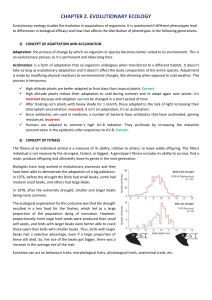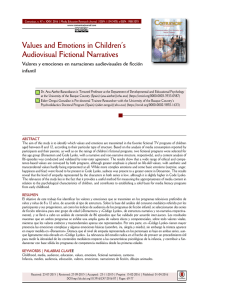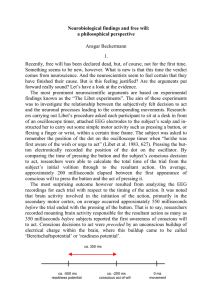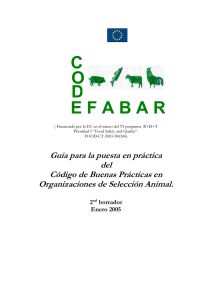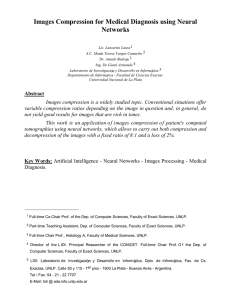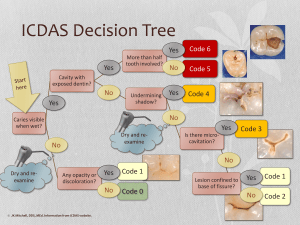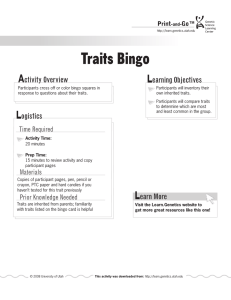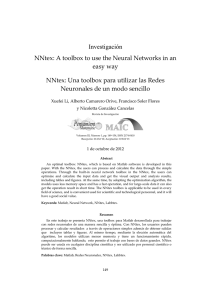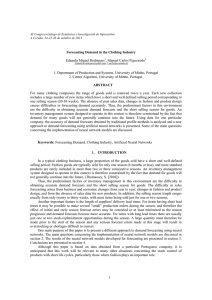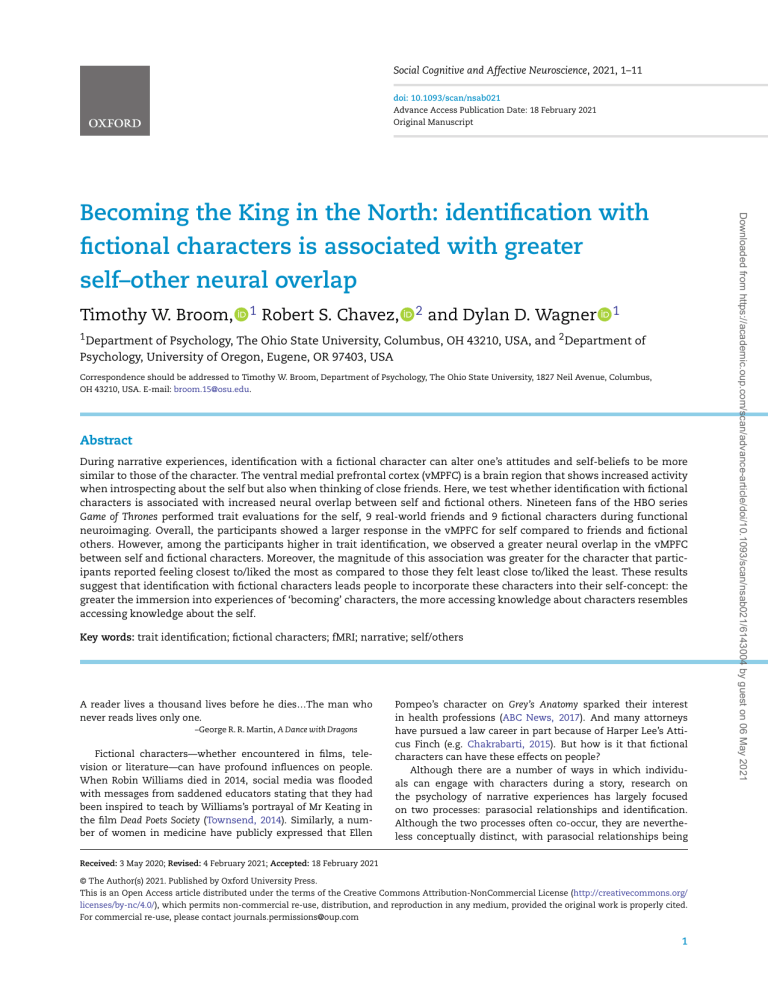
Social Cognitive and Affective Neuroscience, 2021, 1–11 doi: 10.1093/scan/nsab021 Advance Access Publication Date: 18 February 2021 Original Manuscript fictional characters is associated with greater self–other neural overlap Timothy W. Broom,1 Robert S. Chavez,2 and Dylan D. Wagner1 1 Department of Psychology, The Ohio State University, Columbus, OH 43210, USA, and 2 Department of Psychology, University of Oregon, Eugene, OR 97403, USA Correspondence should be addressed to Timothy W. Broom, Department of Psychology, The Ohio State University, 1827 Neil Avenue, Columbus, OH 43210, USA. E-mail: broom.15@osu.edu. Abstract During narrative experiences, identification with a fictional character can alter one’s attitudes and self-beliefs to be more similar to those of the character. The ventral medial prefrontal cortex (vMPFC) is a brain region that shows increased activity when introspecting about the self but also when thinking of close friends. Here, we test whether identification with fictional characters is associated with increased neural overlap between self and fictional others. Nineteen fans of the HBO series Game of Thrones performed trait evaluations for the self, 9 real-world friends and 9 fictional characters during functional neuroimaging. Overall, the participants showed a larger response in the vMPFC for self compared to friends and fictional others. However, among the participants higher in trait identification, we observed a greater neural overlap in the vMPFC between self and fictional characters. Moreover, the magnitude of this association was greater for the character that participants reported feeling closest to/liked the most as compared to those they felt least close to/liked the least. These results suggest that identification with fictional characters leads people to incorporate these characters into their self-concept: the greater the immersion into experiences of ‘becoming’ characters, the more accessing knowledge about characters resembles accessing knowledge about the self. Key words: trait identification; fictional characters; fMRI; narrative; self/others A reader lives a thousand lives before he dies…The man who never reads lives only one. –George R. R. Martin, A Dance with Dragons Fictional characters—whether encountered in films, television or literature—can have profound influences on people. When Robin Williams died in 2014, social media was flooded with messages from saddened educators stating that they had been inspired to teach by Williams’s portrayal of Mr Keating in the film Dead Poets Society (Townsend, 2014). Similarly, a number of women in medicine have publicly expressed that Ellen Pompeo’s character on Grey’s Anatomy sparked their interest in health professions (ABC News, 2017). And many attorneys have pursued a law career in part because of Harper Lee’s Atticus Finch (e.g. Chakrabarti, 2015). But how is it that fictional characters can have these effects on people? Although there are a number of ways in which individuals can engage with characters during a story, research on the psychology of narrative experiences has largely focused on two processes: parasocial relationships and identification. Although the two processes often co-occur, they are nevertheless conceptually distinct, with parasocial relationships being Received: 3 May 2020; Revised: 4 February 2021; Accepted: 18 February 2021 © The Author(s) 2021. Published by Oxford University Press. This is an Open Access article distributed under the terms of the Creative Commons Attribution-NonCommercial License (http://creativecommons.org/ licenses/by-nc/4.0/), which permits non-commercial re-use, distribution, and reproduction in any medium, provided the original work is properly cited. For commercial re-use, please contact journals.permissions@oup.com 1 Downloaded from https://academic.oup.com/scan/advance-article/doi/10.1093/scan/nsab021/6143004 by guest on 06 May 2021 Becoming the King in the North: identification with 2 | Social Cognitive and Affective Neuroscience, 2021, Vol. 00, No. 00 that vMPFC activation in response to others reflects a mechanism whereby we draw on our own self-knowledge as a model to make inferences about others, but only when such knowledge is deemed relevant such as when others are similar to ourselves (Mitchell et al., 2006; Jenkins et al., 2008; Mitchell, 2008). But what about when those others are fictional characters? If identification with fictional others increases the degree to which people experience a character’s mental and emotional states as their own, might they then similarly draw on the vMPFC when later making judgments of fictional characters? In the present study, we used functional neuroimaging to examine the activity in the vMPFC for the self, real-world friends and fictional characters during a commonly used personalitytrait-evaluation task (e.g. Krienen et al., 2010; Mitchell et al., 2011; Ganesh et al., 2012; Tamir and Mitchell, 2012; Chavez et al., 2017; Kang et al., 2018; Chavez and Wagner, 2020) to test whether individual differences in identification with fictional characters are associated with increased neural overlap between self and fictional others within the vMPFC. Participants were self-identified fans of the popular HBO television series Game of Thrones, a series that is known for having a passionate fan base that forms strong emotional ties with the show’s characters as evidenced by their extreme reactions when those characters are inevitably killed off (e.g. https://twitter.com/RedWeddingTears). In line with the work reviewed above, we hypothesized that the tendency to inhabit the first-person experiences of fictional characters during narrative engagement (i.e. trait identification) would lead to downstream consequences of the neural representation of these characters when brought to mind outside of the narrative context. Using an independent localizer task to identify the region of the vMPFC involved in self-referential processing, we hypothesized that this region’s response for self and fictional characters would be more similar for participants high in trait identification. Moreover, because different forms of engagement with fictional characters can be closely related—parasocial processes, for example, can lead to identification with characters (Brown, 2015)—we additionally tested whether trait identification was associated with increased neural overlap between fictional characters and real-life friends. If differences in the neural representation of fictional characters at different levels of trait identification were due to parasocial attachment instead of or in addition to identification, one would expect these differences to take the form of more similar neural responses between friends and fictional characters rather than between the self and fictional characters, as identification would predict. Materials and methods Participants Twenty-six right-handed magnetic resonance imaging (MRI) eligible fans of the HBO series Game of Thrones were recruited to participate in the present study. Seven participants were excluded due to insufficient variance in character ratings across the 9 television show characters selected for inclusion in the study (see below for further details), leaving a total of 19 healthy righthanded participants (10 female; median age = 24; range: 18–37 years) with normal or corrected-to-normal visual acuity who underwent functional neuroimaging. Participants were scanned during the airing of the seventh season of the television series as it was expected that thoughts and feelings about the characters would be at their most accessible while a season was ongoing. All participants were self-reported fans of the series as determined by an adapted six-item measure of consumer devotion Downloaded from https://academic.oup.com/scan/advance-article/doi/10.1093/scan/nsab021/6143004 by guest on 06 May 2021 defined as a one-sided relationship with a media figure (e.g. news anchor, podcaster and celebrity) or a fictional character in which the feeling of attachment persists beyond the immediate narrative or media experience, much like an ongoing friendship (Schramm and Hartmann, 2008; Brown, 2015). Prior research has demonstrated that fictional characters can ‘stand in’ for real friends, alleviating feelings of loneliness and providing the experience of belonging (Derrick et al., 2009). Identification with a fictional character, on the other hand, can be viewed as a form of narrative transportation (Green and Brock, 2000) whereby one is transported into the first-person psychological perspective of a character, adopting his/her viewpoint, goals and mental states within the narrative (Oatley, 1999; Cohen, 2001). Whereas parasocial processes involve imagining oneself interacting with a character, identification involves a loss of one’s sense of self as one in essence ‘becomes’ the character during the narrative experience (Oatley, 1999; Cohen, 2001; Kaufman and Libby, 2012). Further, while parasocial relationships can serve belongingness motivations (see Baumeister and Leary, 1995), identification is theorized to serve the motivation to expand the boundaries of the self by allowing one to adopt more identities, perspectives and experiences than would ever be possible through the course of everyday life (Mar and Oatley, 2008; Slater et al., 2014). Research shows that the greater one’s identification with a character, the more likely it is that one’s self-beliefs, attitudes and behaviors will change to become more similar to those of the character (Igartua, 2010; Sestir and Green, 2010; Kaufman and Libby, 2012; Djikic and Oatley, 2014). Moreover, there is evidence that identification with characters continues to influence people after the narrative experience is over by increasing cognitive elaboration on the story and its characters (Igartua, 2010), thereby contributing to greater attitude change in the spectator (Hamby et al., 2017). Together, this work demonstrates that the merging of self and other that identification with fictional characters entails can leave lasting impacts on the self, but the precise means by which it does so remains an open question. One potential mechanism that has been proposed is that simulating the goals and mental states of the character leads people to internalize these experiences and respond to them as if they had happened to themselves (Kaufman and Libby, 2012). This suggests that identification with a fictional character might lead people to rely on the same neural machinery to represent knowledge about fictional characters as they use to represent their own self-knowledge. Research on the functional neuroanatomy of self-referential processing (e.g. self-knowledge, introspection and prospection) has long implicated a role for the ventral portion of the medial prefrontal cortex (vMPFC) in representing knowledge about the self. Across a wide range of tasks, the vMPFC has been shown to have a greater response during the retrieval of self-knowledge than knowledge of others (for reviews, see Jenkins and Mitchell, 2011; Denny et al., 2012; Wagner et al., 2012). Moreover, damage to this region has been shown to impair the ability to retrieve self-knowledge (Philippi et al., 2012) while leaving trait knowledge concerning others intact (Marquine et al., 2016), suggesting a causal role for this region in accessing self-relevant information. Although this work demonstrates that the vMPFC is recruited preferentially during self-referential processing, activation in this region is also observed when thinking of social targets other than the self. Research has shown that greater vMPFC activation is elicited when individuals think of similar over dissimilar others (Mitchell et al., 2006; Jenkins et al., 2008) as well as interpersonally close others relative to strangers (Krienen et al., 2010). Mitchell and colleagues have proposed T. W. Broom et al. | 3 (Ortiz et al., 2013, p. 28; items 1, 2, 3, 7, 8 and 9) and were up to date on the current events of the series (i.e. had previously viewed all 60 episodes prior to the airing of the seventh season). Participants gave informed consent in accordance with the guidelines set by the Office of Responsible Research Practices at The Ohio State University. Stimuli and fictional character selection Procedure Prior to participating, participants completed a survey asking them to provide information on 9 self-selected friends/ acquaintances with whom they were personally familiar. Participants were asked to select a set of people who varied in terms of how close they felt to them (closeness range: 32–100) and were asked not to include romantic partners or immediate family members. They reported each target person’s name, their relationship to that person (e.g. friend and coworker) and how long they had known them. They also provided the same 0–100 scale ratings of familiarity, closeness, similarity to self and liking as they had for the fictional characters. These 9 real-world friends were included in the task described below. Prior to undergoing functional MRI, participants were tested to ensure they were familiar with the nine target characters. They did this first by completing a matching task where Tasks and experimental design All stimuli were presented and responses recorded in PsychoPy2 (Peirce, 2007, 2009). While in the scanner, participants completed two versions of a standard trait-evaluation task widely used in studies on self-referential processing (e.g. Krienen et al., 2010; Mitchell et al., 2011; Moran et al., 2011; Ganesh et al., 2012; Tamir and Mitchell, 2012; Kang et al., 2018; Chavez and Wagner, 2020), with the first version serving as a functional localizer for the vMPFC. Participants were presented with two words arranged vertically in black text against a gray background. For each target trial, the top word displayed was either ‘SELF’, ‘BUSH’ or ‘CASE’, and the bottom word displayed was 1 of 30 valence-balanced trait adjectives (Anderson, 1968). Each word pairing was displayed for 2000 ms followed by 500 ms of fixation. Intermittent jittered fixation trials (2500–7500 ms) were also included, and the order of event presentation was optimized using Optseq2 (Dale, 1999). For self and Bush trials, participants made a ‘yes’ or ‘no’ judgment as to whether the co-presented trait word accurately described themselves or former United States President George W. Bush, respectively. For the case trials, participants responded ‘yes’ or ‘no’ to the question of whether the trait adjective displayed was in all capital letters. This task consisted of one functional run with 30 trials per condition. As in previous research using this task as a functional localizer (e.g. Krienen et al., 2010; Mitchell et al., 2011; Tamir and Mitchell, 2012; Chavez and Wagner, 2020), we used the contrast of Self > Other trials to define a region of interest (ROI) within the vMPFC independent of the main task. For the main task, the same basic trait-evaluation task was used but without the case condition included (Figure 1B). The targets of the trait judgments were nine fictional characters (which were common across all participants), nine personally familiar friends and acquaintances (specific to each participant) and the self. Thirty-six valence-balanced trait adjectives, none of which overlapped with the 30 included in the functional localizer, were included once for each target. Intermittent jittered fixation trials (2500–5000 ms) were again included. There were six runs of the main task, each consisting of six judgments for each of the 19 targets. Opseq2 (Dale, 1999) was used for optimizing the order stimulus event presentation to maximize efficiency of hemodynamic response estimation. The top six best-performing designs were chosen as the templates for the six runs of the main task. Each template consisted of placeholders for each condition type and the order of the six versions was randomized across participants, as was which target replaced which placeholder, resulting in a unique order of trials across the experiment for every participant, thereby obviating any potential trial-order effects. Including the functional localizer task, the total duration for these two tasks was approximately 47 min. Downloaded from https://academic.oup.com/scan/advance-article/doi/10.1093/scan/nsab021/6143004 by guest on 06 May 2021 Characters from Game of Thrones were selected as targets due to the comparatively large cast of characters from which to select as well as the propensity of fans to form attachments to different characters (e.g. some fans love the conniving Lannisters, whereas others align themselves with the honorable Starks). This allowed us to select a subset of characters to use in the present study that were the same across all participants but toward which individual participants reported varying degrees of closeness (e.g. some participants felt closest to Jaime Lannister and others to Jon Snow). Prior to participation in the study, participants provided ratings on scales from 0 to 100 of familiarity, closeness, similarity to self, liking, emotional attachment and the extent to which they viewed each character as a friend for 25 Game of Thrones characters. These last two items, the second of which was adapted from a measure of parasocial interaction (Rubin et al., 1985), were highly correlated with the closeness measure (closeness and emotional attachment: r = 0.83; closeness and extent to which characters were viewed as friends: r = 0.84), indicating that subjects correctly understood the intended meaning of the closeness measure as indicating a feeling of interpersonal connection and attachment. These ratings were then used to determine which of 25 principle television show characters to select as targets for the study. The following nine characters were chosen based on their overall familiarity and the degree to which they exhibited variance in closeness ratings (closeness range: 65–100; s.d.: 16.39–32.67): Bronn, Catelyn Stark, Cersei Lannister, Davos Seaworth, Jaime Lannister, Jon Snow, Petyr Baelish, Sandor Clegane and Ygritte (Figure 1A). Finally, to be included in the study, subjects had to have a range of at least 50 and s.d. of at least 17 in their closeness ratings of the 9 target characters. These criteria ensured that each participant exhibited variance in closeness ratings, which allowed us to test the extent to which differences in the neural representation of fictional characters for individuals high vs low in trait identification were driven by participants’ feelings toward particular characters. they had to match each character’s name to the correct corresponding picture from a set of character photos. Next, they were asked to verbally provide one fact about each target character. Participants providing incorrect responses for any of the characters were asked to review biographies for those characters (adapted from fansites, e.g. http://www.westeros.org/ GoT/Characters/) to refresh their memories. This was necessary for only 4 of the 19 participants, with 3 characters being the highest number of errors on the matching task. All four of these participants were able to provide an additional novel fact for each of the mismatched characters after reviewing their biographies, suggesting that they then recalled who the characters were. 4 | Social Cognitive and Affective Neuroscience, 2021, Vol. 00, No. 00 character is a violin plot displaying the distribution across participants of the 0–100 ratings of similarity to self (blue), liking (orange) and closeness (green). The width of each plot reflects the density of responses within that range of the scale for each rating type. Vertical lines within each plot mark the lower extrema, mean and higher extrema for each rating type. (B) Examples of the trait-evaluation task completed while participants underwent functional magnetic resonance imaging. Target trials were randomly intermixed with jittered fixation. On each trial, participants made a yes–no judgment using a two-button button box as to whether the trait word presented below the dash accurately described the target presented above the dash. These judgments were made for 19 targets in total: the self, nine fictional characters and nine self-selected personally familiar friends and acquaintances. On target trials, the co-presented target and trait word appeared for 2000 ms followed by 500 ms of fixation. Post-scanner survey Immediately after scanning, participants completed a final survey that consisted of additional ratings of the targets (nine Friends, nine Fictional Characters and the Self), as well as several individual difference measures described below. First, because the seventh season of the series was ongoing, participants were asked whether or not their feelings toward any of the target fictional characters had changed since their original ratings (i.e. on the prescreening survey) due to events in the new episodes. If so, participants adjusted their original ratings to better reflect their current feelings, and these updated ratings were used in the analyses. Participants also completed the interpersonal reactivity index (IRI; Davis, 1983), the UCLA Loneliness Scale (Russell, 1996) and the Transportability Scale (Dal Cin et al., 2004) that measures a general tendency to become transported into narratives (see Green and Brock, 2000). Finally, participants completed the Ten-Item Personality Inventory (Gosling et al., 2003) for all 19 targets. Trait identification was measured using the Fantasy subscale of the IRI, which captures the tendency to ‘transpose [oneself] imaginatively into the feelings and actions of fictitious characters in books, movies, and plays’ (Davis, 1983, p. 114) and includes items such as ‘I really get involved with the feelings of the characters in a novel’. However, due to potential concerns about conceptual overlap between our measure of trait identification and trait transportability, we additionally conducted post hoc analyses with two separately constructed measures of trait identification and trait transportability that were created by recategorizing items across both scales as reflecting either identification processes or transportation broadly speaking (i.e. a tendency to become absorbed in stories, but with no emphasis on being transported into the first-person psychological perspective of characters). The Downloaded from https://academic.oup.com/scan/advance-article/doi/10.1093/scan/nsab021/6143004 by guest on 06 May 2021 Fig. 1. (A) The nine Game of Thrones characters selected as targets in the study based on the high levels of variance in participants’ ratings of closeness. Below each T. W. Broom et al. | 5 recategorization of the scale items is included in the Supplemental Materials (Table S8) along with all analyses using the recategorized trait identification and trait transportability scores (pp. 12–14). In general, the pattern of results is consistent whether using the recategorized measures or the scales in their original forms though in some cases the results of secondary analyses did not reach statistical significance with the recategorized measures. MRI was conducted with a Siemens Prisma 3 Tesla scanner using a 32-channel phased array coil. Structural images were acquired using a T1-weighted MP-RAGE protocol (176 sagittal slices; repetition time (TR): 1900 ms; time to echo (TE): 4.4 ms; flip angle: 12◦ ; 1 mm isotropic voxels). Functional images were acquired using a T2*-weighted echo planar sequence (TR: 2500 ms; 45 axial slices, TE: 28 ms; flip angle: 76◦ ; 3 mm isotropic voxels). For each participant, we collected one run of the functional localizer task (138 wholebrain volumes) and six runs of the main task (166 whole-brain volumes per run). Image preprocessing Preprocessing was conducted using SPM12 (Wellcome Department of Cognitive Neurology, London) in conjunction with a suite of in-house tools for preprocessing and analysis (SPM12w; https://github.com/wagner-lab/spm12w). First, images were corrected for differences in acquisition time between slices and then realigned within and across runs via a rigid body transformation in order to correct for head movement. Images were unwarped to reduce residual movement-related image distortions not corrected for by realignment and then normalized into a standard stereotaxic space (3 mm isotropic voxels) based on the SPM12 EPI template that conforms to the ICBM 152 brain template space (Montreal Neurological Institute). Normalized images were spatially smoothed (4 mm full-widthat-half-maximum) using a Gaussian kernel to increase the signal-to-noise ratio (SNR). Volumes were inspected for scannerand motion-related artifacts based on an examination of the realignment parameters and temporal SNR for each run in each participant. Functional localizer For each participant, a general linear model (GLM) was constructed to investigate category-specific brain activity. This GLM, incorporating covariates of no interest (a linear trend to account for low-frequency drift, movement parameters), was convolved with a canonical hemodynamic response function and used to compute parameter estimates (β) and contrast images (containing weighted parameter estimates) at each voxel. First-level analyses investigated the Self > Bush contrast. The results of this functional localizer task were then submitted to group-level random effects analyses to isolate regions of the brain involved in self-referential processing (P < 0.05 corrected at the cluster level). This analysis identified a cluster in the vMPFC that was then used as a ROI (6 mm spherical ROI with a peak centered at Montreal Neurological Institute [MNI] coordinates: 6, 42, 3) for subsequent analysis of the main task. Results Comparison of Self, Friends and Fictional Characters within the vMPFC Trait-judgment task analysis For the data collected from the trait-judgement task, two GLMs were constructed for each participant: one with the three main Based on an independent self-evaluation functional localizer task, a region of the vMPFC (MNI coordinates: 6, 42, 3) was identified as showing a greater response to self-referential vs Downloaded from https://academic.oup.com/scan/advance-article/doi/10.1093/scan/nsab021/6143004 by guest on 06 May 2021 Image acquisition categories (Self, Friends and Fictional Characters) and one with each individual identity (i.e. 18 identities plus self) defined separately. To examine average differences between categories, whole-brain statistical maps (P < 0.05, corrected at the cluster level) were produced for each condition over baseline as well as the following contrasts: Self > Friends, Self > Fictional Characters and Friends > Fictional Characters. The resulting whole-brain maps were examined to identify regions displaying group-level significant differences in activation for one category over another. We also examined average differences between categories within the independently defined vMPFC ROI. Regression analyses were conducted to test whether individual differences in the tendency to identify with fictional characters, and thus to internalize characters’ experiences, were associated with self–other neural overlap. Self–other neural overlap was calculated by taking the mean-weighted parameter estimates for the contrast of Self > Fictional Characters from the independently defined vMPFC ROI. Values closer to zero indicate less of a difference in the level of activation in the vMPFC observed when thinking about the self vs fictional characters. Because one participant could be considered an outlier with respect to their trait identification score (defined as being more than 2.5 s.d. away from the sample mean), robust regression was implemented using the Robust Linear Models function from the statsmodels package in Python (Seabold and Perktold, 2010) with Huber’s T for M-estimation. Follow-up analyses explored whether the subjective ratings of the characters (i.e. closeness, liking, similarity to self or familiarity) might explain which characters (or, more precisely, which particular feelings toward/perceptions of those characters) were of particular importance in driving the association between trait identification and self–other neural overlap with fictional characters. To test this, the contrast of Self > Fictional Characters was computed separately for each of the 9 fictional characters within the independently defined vMPFC ROI. Robust regression was used to calculate the association between self–other neural overlap and trait identification for the top and bottom ranked character based on participants’ ratings of closeness, liking, similarity to self and familiarity. We then tested whether the slope associated with the top ranked character was significantly greater in magnitude than that associated with the bottom ranked character (Paternoster et al., 1998). In addition to the main analyses described above, several additional analyses were conducted to establish the specificity of the reported effect. To assess whether the relationship between trait identification and vMPFC activity was specific to fictional characters, we additionally tested whether trait identification was associated with self–other neural overlap with friends. Next, robust multiple regression was used to examine whether trait identification explained unique variance in self–other neural overlap with fictional characters beyond that explained by the related, more general construct of trait transportability. Finally, to determine whether differences in the neural response to fictional characters were reflective of parasocial processes instead of or in addition to identification, we tested whether trait identification was associated with neural overlap between fictional characters and friends/acquaintances. 6 | Social Cognitive and Affective Neuroscience, 2021, Vol. 00, No. 00 showed the greatest activation for Self trials followed by Friend trials followed by Fictional Character trials (Self vs Friends: t18 = 3.72, P = 0.002; Self vs Fic- Fig. 3. Brain regions showing greater activation (P < 0.05, corrected) for Self tri- tional Characters t18 = 9.80, P < 0.001; Friends vs Fictional Characters t18 = 5.77, als vs Friend trials, Self trials vs Fictional Character trials and Friend trials vs P < 0.001). Inset shows location of ROI (6, 42, 3). Coordinates (x, y, z) are in Fictional Character trials. Montreal Neurological Institute stereotaxic space. other referential judgements (see Table S2 and Figure S1 in Supplementary Materials for full whole-brain results of the selfevaluation functional localizer). Neural responses during the trait-evaluation task were extracted for Self, Friends and Fictional Characters from a 6 mm spherical ROI centered at this peak. A repeated measures analysis of variance (ANOVA) indicated a main effect of target (F2,36 = 46.08, P < 0.001) such that the vMPFC showed a general pattern of Self > Friends > Fictional Characters (Self vs Friends: t18 = 3.72, P = 0.002; Self vs Fictional Characters t18 = 9.80, P < 0.001; Friends vs Fictional Characters t18 = 5.77, P < 0.001). These results (displayed in Figure 2) are consistent with some previous work showing that the vMPFC distinguishes between the self and even close friends (Heatherton et al., 2006; cf. Krienen et al., 2010). Whole-brain analysis comparing Self, Friends and Fictional Characters Comparisons between the Self, Friends and Fictional Characters were also examined at the whole-brain level (see Figure 3 and Tables S2–S7 in Supplementary Materials). Overall, results showed a general pattern of greater neural activity for both Self vs Fictional Characters and Friends vs Fictional Characters (P < 0.05 corrected) in midline structures commonly implicated in self-referential cognition and in social cognition, namely the MPFC as well as areas of the precuneus and posterior cingulate cortex. In contrast, the areas of the MPFC showing greater activity for the Self vs Friends were much more restricted. In addition, greater activity was observed for the Self relative to both Friends and Fictional Characters in the temporoparietal junction bilaterally and the superior temporal sulcus bilaterally. Trait identification and self–other neural overlap with fictional characters To test whether individuals high in the tendency to identify with fictional characters show greater self–other neural overlap in the vMPFC when accessing knowledge about those characters, we used robust regression to predict the contrast of Self > Fictional Characters from trait identification scores. This analysis revealed that individuals higher in trait identification Fig. 4. Scatterplot depicting the association between trait identification and the blood oxygen level–dependent response difference to all Self trials vs Fictional Character trials in the independently defined vMPFC ROI. Trait identification scores were recoded such that the lowest possible score on the scale was equal to −1 and the highest possible score was equal to 1. Inset shows location of ROI (6, 42, 3). Coordinates (x, y, z) are in Montreal Neurological Institute stereotaxic space. exhibited more similar activity in the vMPFC when thinking about fictional characters compared to thinking about the self (b = −1.35, SE = 0.35, z = 3.87, P < 0.001; Figure 4). Given that prior work has suggested that the vMPFC is differentially recruited when thinking of others depending on perceptions of interpersonal closeness (Krienen et al., 2010) or similarity to the self (Mitchell et al., 2006; Jenkins et al., 2008), we next examined whether participants’ subjective ratings of the characters (i.e. closeness, liking, similarity to self and familiarity) might modulate the association between trait identification and self–other neural overlap with fictional characters. To do Downloaded from https://academic.oup.com/scan/advance-article/doi/10.1093/scan/nsab021/6143004 by guest on 06 May 2021 Fig. 2. Parameter estimates within the independently defined vMPFC ROI T. W. Broom et al. | 7 Trait identification and self–other neural overlap with friends To determine whether the reported effect was specific to fictional characters, we additionally tested the association between trait identification and self–other neural overlap with friends. There was no significant association between trait identification and self–other neural overlap with friends (b = −0.32, SE = 0.42, z = 0.77, P = 0.44). Direct comparison of the magnitude of this slope with that for identification predicting self–other neural overlap with characters was in the expected direction but was marginal with respect to being significantly different in magnitude (z = 1.88, P = 0.06). Does trait identification predict unique variance beyond trait transportability? Because we define identification as a specific form of narrative transportation whereby one is transported specifically into the first-person psychological perspective of characters, we next determined whether trait identification explained unique variance in self–other neural overlap with fictional characters beyond trait transportability, or a general tendency to get absorbed in stories without any emphasis on the position one takes within the narrative events. While there was also a significant association between self–other neural overlap with fictional characters and trait transportability (b = −2.06, SE = 1.00, z = 2.05, P = 0.04), when the two measures were simultaneously entered into a robust regression predicting self–other neural overlap with fictional characters, only trait identification remained a significant predictor (trait identification: b = −1.13, SE = 0.40, z = 2.81, P = 0.005; trait transportability: b = −0.80, SE = 0.91, z = 0.89, P = 0.38). Trait identification and neural overlap between friends and fictional characters Because identification is closely related to and can be preceded by parasocial interactions/relationships (Brown, 2015), we additionally assessed whether trait identification was associated with neural overlap between fictional characters and real-life friends and acquaintances, which would suggest that differences in the neural response when thinking of fictional characters reflect the downstream consequences of parasocial processes in addition to identification. To test this, we examined the association between trait identification and neural overlap across all fictional characters and personally familiar friends/acquaintances. Trait identification was significantly associated with neural overlap between fictional characters and real-life friends and acquaintances (b = −0.73, SE = 0.34, z = 2.13, P = 0.03), and this slope was not significantly smaller in magnitude than that observed for trait identification and self–other neural overlap with fictional characters (z = 1.27, P = 0.20). Discussion When individuals engage in narrative experiences, they have the chance to take on countless new identities, to see worlds through others’ eyes and to return from these experiences changed. The notion that narrative fiction has such an impact on individuals, long argued by literary scholars, is strongly supported by empirical evidence that identification with a fictional character can lead to changes in individuals’ self-beliefs, attitudes and behaviors (Igartua, 2010; Sestir and Green, 2010; Kaufman and Libby, 2012; Djikic and Oatley, 2014). The current study expands on this behavioral work by highlighting a potential neural mechanism by which these changes can occur. Here, we demonstrate that individuals higher in trait identification exhibit greater self–other neural overlap with fictional characters in the vMPFC, a brain region that is commonly implicated in self-referential processing (Jenkins and Mitchell, 2011; Denny et al., 2012; Wagner et al., 2012) and in which damage is associated with impaired accessibility of self-referential knowledge (Philippi et al., 2012; Marquine et al., 2016). Specifically, we show that neural responses for Self and Fictional Characters are more similar among individuals who regularly mentally simulate narrative experiences from the first-person psychological perspective of characters within the story (i.e. trait identification). This finding suggests that the more immersed people tend to get in experiences of ‘becoming’ a fictional character, the more likely they are to access knowledge about that identity using the same neural machinery as they do to access knowledge about themselves. This is consistent with the theoretical definition of identification as a merging of self and other (Oatley, 1999; Cohen, 2001; Kaufman and Libby, 2012). Because these individuals internalize the experiences of the character as their own, accessing knowledge about those characters more closely resembles accessing autobiographical knowledge. Further, the results of the current study provide preliminary evidence that this may be especially likely to be true for the characters to which individuals feel closest/who they like the most. It has been proposed that vMPFC activity in response to evaluations of others reflects the extent to which the self is being drawn on as a model to understand the mental states and/or traits of the target (Mitchell et al., 2006; Jenkins et al., 2008; Mitchell, 2008), as suggested by simulation theories of social cognition (e.g. Gordon, 1986). This previous work relies primarily on paradigms using novel targets that are manipulated to be perceived as either similar or dissimilar to the participant. In the current study, however, the targets were not novel but rather well-known fictional characters. It is unclear, therefore, whether individuals higher in trait identification were more likely to draw on the self as a model when evaluating fictional characters, or if accessing knowledge about fictional characters is, in a sense, the same as accessing self-knowledge. An altogether different interpretation of the finding comes from the proposal of Buckner and colleagues that the vMPFC reflects the personal significance of stimuli (Andrews-Hanna et al., 2010), e.g. in the case of judgments of others, the relevance of those Downloaded from https://academic.oup.com/scan/advance-article/doi/10.1093/scan/nsab021/6143004 by guest on 06 May 2021 this, self–other neural overlap was calculated for each individual character (i.e. the parameter estimate for the contrast of Self > Individual Fictional Character within the vMPFC ROI). Next, the association between trait identification and self–other neural overlap was computed for the top and bottom ranked characters based on participants’ subjective ratings. Results indicated that the slope observed for the closest ranked character (b = −2.10, SE = 0.42, z = 4.98, P < 0.001) was greater in magnitude (z = 2.23, P = 0.03) than that observed for the least close ranked character (b = −0.64, SE = 0.50, z = 1.27, P = 0.20). Similarly, the slope observed for the most liked character (b = −2.27, SE = 0.37, z = 6.09, P < 0.001) was greater in magnitude (z = 2.25, P = 0.02) than that observed for the least liked character (b = −0.68, SE = 0.60, z = 1.14, P = 0.25). The slope for the top and bottom ranked characters were not significantly different from one another for ratings of similarity to self or ratings of familiarity (Ps > 0.24). 8 | Social Cognitive and Affective Neuroscience, 2021, Vol. 00, No. 00 potentially important factors in the association between trait identification and self–other neural overlap with fictional characters. It may be the case that perceived similarity is a strong predictor when narrative experiences are short, and there is little time to form a meaningful emotional attachment to a character. In this way, studies relying on short narrative experiences are somewhat analogous to the work discussed above (e.g. Mitchell et al., 2006; Krienen et al., 2010), in which participants quickly form impressions of novel identities. However, when narrative experiences become longer, it may be the case that closeness and liking become more important for identification. There are several reasons why individuals higher in trait identification might be better able to inhabit the first-person perspective of a character, regardless of that character’s similarity to the self. Because these individuals regularly and readily mentally simulate the mental states of fictional characters, it may simply be a matter of being more practiced at simulating the thoughts and feelings of a diverse set of identities (Mar and Oatley, 2008). A recent work by Tamir and colleagues suggests that individuals who read more fiction perform better on social cognitive tasks and that this association is mediated by the extent to which the dorsomedial prefrontal cortex (dMPFC) subnetwork of the default mode network (Andrews-Hanna et al., 2010) is recruited during reading of social passages (Tamir et al., 2016). This work supports the idea that certain individuals are more practiced at simulating the mental states of others and suggests a potential antecedent to self–other neural overlap with fictional characters (i.e. greater recruitment of the dMPFC subnetwork during portions of the story featuring a given character). In addition to being a matter of ability, individuals higher in trait identification may also be especially motivated to simulate identities that are different from their own as previous research suggests that a strong motivation to engage with narratives is to explore alternate identities in order to expand the boundaries of the self (Slater et al., 2014). Feelings of closeness/liking to characters, then, might in some cases motivate identification and in other cases be a consequence of it. Our results showed that transportability was also associated with self–other neural overlap with fictional characters, but this association disappeared when including identification in the model. Narrative transportation is a state of immersion in the events occurring within a story, which, like identification, can lead to changes in attitudes (Green and Brock, 2000) and self-beliefs (Green et al., 2004; Shedlosky-Shoemaker et al., 2014). Identification and narrative transportation are related constructs (e.g. Hall and Bracken, 2011), but whereas transportation captures immersion into the story in general, identification involves immersion specifically into the psychological perspective of a character. Trait identification explained unique variance in self–other neural overlap with fictional characters beyond that explained by transportability, suggesting that being immersed in the narrative events as a spectator is not sufficient for the internalization of characters’ experiences; one must be actively immersed in the roles and mental states of the characters (Oatley, 1999). Although there were concerns regarding conceptual overlap between our measures of trait identification and trait transportability, the relative emphasis of each measure on identification specifically as opposed to transportation more generally was consistent with its labeling (i.e. the trait identification measure had a larger proportion of items clearly capturing identification; Supplementary Table S8). Further, after recategorizing all scale items to more directly target each construct, trait identification still explained unique variance in self–other neural overlap with fictional characters beyond trait transportability (Supplemental Materials, p. 13). Downloaded from https://academic.oup.com/scan/advance-article/doi/10.1093/scan/nsab021/6143004 by guest on 06 May 2021 others to one’s own survival (Krienen et al., 2010). Under this interpretation, the greater self–other neural overlap observed for individuals higher in trait identification simply reflects the greater personal significance/relevance of fictional characters to these individuals. This interpretation is arguably more consistent conceptually with a parasocial processes explanation of the current findings, for which there was some evidence in the form of an association between trait identification and neural overlap between friends and fictional characters. A key difference between parasocial processes and identification is that one retains his/her sense of self during parasocial processes, imagining what it would be like to interact with or be friends with the character in question (Cohen, 2001; Brown, 2015). Evidence suggests that individuals do in fact respond to fictional characters similarly to how they would respond to a real-life friend. Thinking of fictional characters can alleviate loneliness (Derrick et al., 2009), being in the ‘presence’ of fictional characters can lead to social facilitation/inhibition effects (Gardner and Knowles, 2008) and individuals’ emotional response to the end of a loved television show resembles the response to the end of a friendship (Cohen, 2003). Therefore, we have argued that parasocial processes would most likely be reflected in neural overlap between fictional characters and real-life friends/acquaintances rather than neural overlap between fictional characters and the self. Although the association between trait identification and self–other neural overlap with fictional characters was greater in magnitude, there was also a significant association between trait identification and neural overlap between friends and fictional characters, suggesting that both identification and parasocial processes may influence vMPFC activity in response to thinking of fictional characters. Because identification is not necessarily a sustained state but rather can be ‘fleeting and vary in intensity’ (Cohen, 2001, p. 250), and because identification is closely related to parasocial processes with some work suggesting that the latter is an antecedent to the former (Brown, 2015), disentangling the distinct role of each process on the neural representation of well-known fictional characters may prove difficult. Previous research, however, highlights the importance of inhabiting the first-person perspective and role of a fictional character with respect to predicting vMPFC activity, providing additional evidence that responses in this region may reflect a merging of self and other. Greater activation was observed in this region when gamers thought of their World of Warcraft avatar compared to when non-gamer controls thought of their favorite fictional character (Ganesh et al., 2012). Gamers inhabit the perspective of their avatars in a very concrete sense: they control their actions and decisions within the virtual environment, and this influence can go both ways as demonstrated by research showing that the physical appearance of the avatar one inhabits can influence an individual’s subsequent offline, face-to-face interactions (Yee et al., 2009). This element of control over the character, however, makes identification with a videogame avatar distinct from identification with fictional characters from more traditional narratives, as was the focus in the current study. According to Mitchell and colleagues, the self is drawn on to understand others only if the self is deemed an appropriate proxy as tends to occur when we perceive others to be similar to ourselves (Mitchell et al., 2006; Jenkins et al., 2008). Moreover, behavioral work on identification with fictional characters has also focused on perceived similarity to self as a predictor of the ease with which one is able to inhabit the role of a given character (e.g. Oatley, 1999; Kaufman and Libby, 2012). The current findings, however, provide initial evidence for perceived closeness and liking rather than perceived similarity as T. W. Broom et al. | 9 Acknowledgements The authors thank the Center for Cognitive and Behavioral Brain Imaging (CCBBI) at The Ohio State University. Funding The author(s) received no financial support for the research, authorship, and/or publication of this article. Conflict of interest The authors declare that they have no conflict of interest with respect to their authorship or the publication of this article. Author contributions T.W.B., R.S.C. and D.D.W. designed the research. T.W.B. gathered all research data; T.W.B. analyzed the data under the supervision of R.S.C.; D.D.W. T.W.B. and D.D.W. wrote the manuscript and all authors approved the manuscript. Supplementary data Supplementary data are available at SCAN online. References ABC News. (2017). “Grey’s Anatomy” star Ellen Pompeo reacts to the women she inspired to pursue medical careers. ABC News. Available: https://abcnews.go.com/Entertainment/greys-anat omy-star-ellen-pompeo-reacts-women-inspired/story?id=51 035189 [November 9, 2017]. Anderson, N.H. (1968). Likableness ratings of 555 personalitytrait words. Journal of Personality and Social Psychology, 9(3), 272–9. Andrews-Hanna, J.R., Reidler, J.S., Sepulcre, J., Poulin, R., Buckner, R.L. (2010). Functional-anatomic fractionation of the brain’s default network. Neuron, 65(4), 550–62. Baumeister, R.F., Leary, M.R. (1995). The need to belong: desire for interpersonal attachments as a fundamental human motivation. Psychological Bulletin, 117(3), 497–529. Brown, W.J. (2015). Examining four processes of audience involvement with media personae: transportation, parasocial interaction, identification, and worship. Communication Theory, 25(3), 259–83. Chakrabarti, S. (2015). Shami Chakrabarti: To Kill a Mockingbird made me a lawyer. The Guardian. Available: https:// www.theguardian.com/books/2015/jul/11/shami-chakrabartikill-mockingbird-made-me-lawyer [July 11, 2015]. Chavez, R.S., Heatherton, T.F., Wagner, D.D. (2017). Neural population decoding reveals the intrinsic positivity of the self. Cerebral Cortex, 27(11), 5222–9. Chavez, R.S., Wagner, D.D. (2020). The neural representation of self is recapitulated in the brains of friends: a round-robin fMRI study. Journal of Personality and Social Psychology, 118(3), 407–16. Cohen, J. (2001). Defining identification. Mass Communication and Society, 4(3), 245–64. Cohen, J. (2003). Parasocial breakups: measuring individual differences in responses to the dissolution of parasocial relationships. Mass Communication and Society, 6(2), 191–202. Dal Cin, S., Zanna, M.P., Fong, G.T. (2004). Narrative persuasion and overcoming resistance. In: Knowles, E.S., Linn, J.A., editors. Resistance and Persuasion, Mahwah, New Jersey: Lawrence Erlbaum Associates, 175–91. Dale, A.M. (1999). Optimal experimental design for event-related fMRI. Human Brain Mapping, 8(23), 109–14. Davis, M.H. (1983). Measuring individual differences in empathy: evidence for a multidimensional approach. Journal of Personality and Social Psychology, 44(1), 113–26. Denny, B.T., Kober, H., Wager, T.D., Ochsner, K.N. (2012). A meta-analysis of functional neuroimaging studies of self- and other judgments reveals a spatial gradient for mentalizing in medial prefrontal cortex. Journal of Cognitive Neuroscience, 24(8), 1742–52. Derrick, J.L., Gabriel, S., Hugenberg, K. (2009). Social surrogacy: how favored television programs provide the experience of belonging. Journal of Experimental Social Psychology, 45(2), 352–62. Djikic, M., Oatley, K. (2014). The art in fiction: from indirect communication to changes of the self. Psychology of Aesthetics, Creativity, and the Arts, 8(4), 498–505. Erickson, S.E., Dal Cin, S. (2018). Romantic parasocial attachments and the development of romantic scripts, schemas and beliefs among adolescents. Media Psychology, 21(1), 111–36. Erickson, S.E., Harrison, K., Dal Cin, S. (2018). Toward a multidimensional model of adolescent romantic parasocial attachment. Communication Theory, 28(3), 376–99. Downloaded from https://academic.oup.com/scan/advance-article/doi/10.1093/scan/nsab021/6143004 by guest on 06 May 2021 Although Game of Thrones provided an ideal text from which to draw stimuli due to its wide cast of characters toward which different fans form different impressions, the findings reported herein are inherently limited in their generalizability due to the focus on a single television series. In addition, recent evidence suggests that there are differences in the neural representation of romantic partners compared to other close attachment figures (Laurita et al., 2017), highlighting the need for future work in this vein to be sensitive to the nature of the attachment involved as other recent work has similarly identified distinct effects of romantic parasocial attachment as compared to parasocial attachment in general (Erickson and Dal Cin, 2018; Erickson et al., 2018). In the current study, we cannot distinguish between these attachment types as we did not assess the potential for romantic parasocial attachment to the fictional characters chosen as targets. The current study demonstrates that the neural representation of fictional characters within the vMPFC differs between those who readily and regularly experience narratives from the perspectives of characters and those who do not. For individuals high in trait identification, who internalize the experiences of fictional characters, accessing knowledge about fictional characters more closely resembles accessing knowledge about the self, and this may especially be true for those characters to which they feel closest and who they like the most. The evidence presented herein shows that the merging of self and other that identification with fictional characters entails can last beyond the confines of the narrative experience itself. When fictional characters are brought to mind later outside of the narrative context, individuals nevertheless differ in the levels of self–other neural overlap they exhibit. There are countless examples of narrative fiction altering the course of people’s lives by influencing their attitudes, values and, in some extreme cases, even major life decisions such as what career to pursue. When individuals experience stories as if they were one of the characters, a connection with that character is formed and, as our findings suggest, that character becomes intertwined with the self. 10 | Social Cognitive and Affective Neuroscience, 2021, Vol. 00, No. 00 Mitchell, J.P., Macrae, C.N., Banaji, M.R. (2006). Dissociable medial prefrontal contributions to judgments of similar and dissimilar others. Neuron, 50(4), 655–63. Mitchell, J.P. (2008). Contributions of functional neuroimaging to the study of social cognition. Current Directions in Psychological Science, 17(2), 142–6. Mitchell, J.P., Schirmer, J., Ames, D.L., Gilbert, D.T. (2011). Medial prefrontal cortex predicts intertemporal choice. Journal of Cognitive Neuroscience, 23(4), 857–66. Moran, J.M., Lee, S.M., Gabrieli, J.D.E. (2011). Dissociable neural systems supporting knowledge about human character and appearance in ourselves and others. Journal of Cognitive Neuroscience, 23(9), 2222–30. Oatley, K. (1999). Meetings of minds: dialogue, sympathy, and identification, in reading fiction. Poetics, 26(5–6), 439–54. Ortiz, M.H., Reynolds, K.E., Franke, G.R. (2013). Measuring consumer devotion: antecedents and consequences of passionate consumer behavior. Journal of Marketing Theory and Practice, 21(1), 7–30. Paternoster, R., Brame, R., Mazerolle, P., Piquero, A. (1998). Using the correct statistical test for the equality of regression coefficients. Criminology, 36(4), 859–66. Peirce, J.W. (2007). PsychoPy—Psychophysics software in Python. Journal of Neuroscience Methods, 162(1–2), 8–13. Peirce, J.W. (2009). Generating stimuli for neuroscience using PsychoPy. Frontiers in Neuroinformatics, 2(10), 1–8. Philippi, C.L., Duff, M.C., Denburg, N.L., Tranel, D., Rudrauf, D. (2012). Medial PFC damage abolishes the self-reference effect. Journal of Cognitive Neuroscience, 24(2), 475–81. Rubin, A.M., Perse, E.M., Powell, R.A. (1985). Loneliness, parasocial interaction, and local television news viewing. Human Communication Research, 12(2), 155–80. Russell, D.W. (1996). UCLA Loneliness Scale (version 3): reliability, validity, and factor structure. Journal of Personality Assessment, 66(1), 20–40. Schramm, H., Hartmann, T. (2008). The PSI-Process Scales. A new measure to assess the intensity and breadth of parasocial processes. Communications, 33(4), 385–402. Seabold, S., Perktold, J. (2010). Statsmodels: econometric and statistical modeling with Python. Proceedings of the 9th Python in Science Conference, 92–6. Sestir, M., Green, M.C. (2010). You are who you watch: identification and transportation effects on temporary self-concept. Social Influence, 5(4), 272–88. Shedlosky-Shoemaker, R., Costabile, K.A., Arkin, R.M. (2014). Self-expansion through fictional characters. Self and Identity, 13(5), 556–78. Slater, M.D., Johnson, B.K., Cohen, J., Comello, M.L.G., Ewoldsen, D.R. (2014). Temporarily expanding the boundaries of the self: motivations for entering the story world and implications for narrative effects. Journal of Communication, 64(3), 439–55. Tamir, D.I., Bricker, A.B., Dodell-Feder, D., Mitchell, J.P. (2016). Reading fiction and reading minds: the role of simulation in the default network. Social Cognitive and Affective Neuroscience, 11(2), 215–24. Tamir, D.I., Mitchell, J.P. (2012). Disclosing information about the self is intrinsically rewarding. Proceedings of the National Academy of Sciences of the United States of America, 109(21), 8038–43. Townsend, L. (2014). The real teachers inspired by Dead Poets Society. BBC News Magazine. Available: https://www.bbc.com/ news/magazine-28756375 [August 13, 2014]. Downloaded from https://academic.oup.com/scan/advance-article/doi/10.1093/scan/nsab021/6143004 by guest on 06 May 2021 Ganesh, S., Van Schie, H.T., De Lange, F.P., Thompson, E., Wigboldus, D.H.J. (2012). How the human brain goes virtual: distinct cortical regions of the person-processing network are involved in self-identification with virtual agents. Cerebral Cortex, 22(7), 1577–85. Gardner, W.L., Knowles, M.L. (2008). Love makes you real: favorite television characters are perceived as “real” in a social facilitation paradigm. Social Cognition, 26(2), 156–68. Gordon, R.M. (1986). Folk psychology as simulation. Mind & Language, 1(2), 158–71. Gosling, S.D., Rentfrow, P.J., Swann, W.B. (2003). A very brief measure of the Big-Five personality domains. Journal of Research in Personality, 37(6), 504–28. Green, M.C., Brock, T.C., Kaufman, G.F. (2004). Understanding media enjoyment: the role of transportation into narrative worlds. Communication Theory, 14(4), 311–27. Green, M.C., Brock, T.C. (2000). The role of transportation in the persuasiveness of public narratives. Journal of Personality and Social Psychology, 79(5), 701–21. Hall, A.E., Bracken, C.C. (2011). I really liked that movie: testing the relationship between trait empathy, transportation, perceived realism, and movie enjoyment. Journal of Media Psychology, 23(2), 90–9. Hamby, A., Brinberg, D., Daniloski, K. (2017). Reflecting on the journey: mechanisms in narrative persuasion. Journal of Consumer Psychology, 27(1), 11–22. Heatherton, T.F., Wyland, C.L., Macrae, C.N., Demos, K.E., Denny, B.T., Kelley, W.M. (2006). Medial prefrontal activity differentiates self from close others. Social Cognitive and Affective Neuroscience, 1(1), 18–25. Igartua, J.J. (2010). Identification with characters and narrative persuasion through fictional feature films. Communications, 35(4), 347–73. Jenkins, A.C., Macrae, C.N., Mitchell, J.P. (2008). Repetition suppression of ventromedial prefrontal activity during judgments of self and others. Proceedings of the National Academy of Sciences of the United States of America, 105(11), 4507–12. Jenkins, A.C., Mitchell, J.P. (2011). How has cognitive neuroscience contributed to social psychological theory? In: Todorov, A., Fiske, S.T., Prentice, D.A., editors. Social Neuroscience: Toward Understanding the Underpinnings of the Social Mind, New York: Oxford University Press, 3–13. Kang, Y., Cooper, N., Pandey, P., et al. (2018). Effects of self-transcendence on neural responses to persuasive messages and health behavior change. Proceedings of the National Academy of Sciences of the United States of America, 115(40), 9974–9. Kaufman, G.F., Libby, L.K. (2012). Changing beliefs and behavior through experience-taking. Journal of Personality and Social Psychology, 103(1), 1–19. Krienen, F.M., Tu, P.C., Buckner, R.L. (2010). Clan mentality: evidence that the medial prefrontal cortex responds to close others. Journal of Neuroscience, 30(41), 13906–15. Laurita, A.C., Hazan, C., Spreng, R.N. (2017). Dissociable patterns of brain activity for mentalizing about known others: a role for attachment. Social Cognitive and Affective Neuroscience, 12(7), 1072–82. Mar, R.A., Oatley, K. (2008). The function of fiction is the abstraction and simulation of social experience. Perspectives on Psychological Science, 3(3), 173–92. Marquine, M.J., Grilli, M.D., Rapcsak, S.Z., et al. (2016). Impaired personal trait knowledge, but spared other-person trait knowledge, in an individual with bilateral damage to the medial prefrontal cortex. Neuropsychologia, 89, 245–53. T. W. Broom et al. | 11 Wagner, D.D., Haxby, J.V., Heatherton, T.F. (2012). The representation of self and person knowledge in the medial prefrontal cortex. Wiley Interdisciplinary Reviews: Cognitive Science, 3(4), 451–70. Yee, N., Bailenson, J.N., Ducheneaut, N. (2009). The Proteus effect. Communication Research, 36(2), 285–312. Downloaded from https://academic.oup.com/scan/advance-article/doi/10.1093/scan/nsab021/6143004 by guest on 06 May 2021
